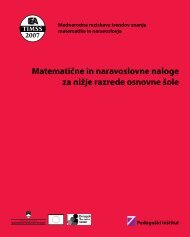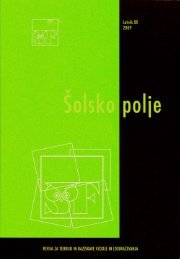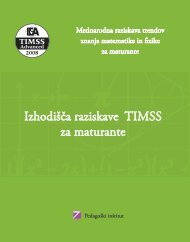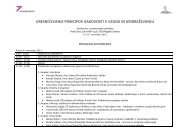Šolsko polje, letnik XX, številka 5-6, 2009: Vloga ... - Pedagoški inštitut
Šolsko polje, letnik XX, številka 5-6, 2009: Vloga ... - Pedagoški inštitut
Šolsko polje, letnik XX, številka 5-6, 2009: Vloga ... - Pedagoški inštitut
You also want an ePaper? Increase the reach of your titles
YUMPU automatically turns print PDFs into web optimized ePapers that Google loves.
TOPOI IN CRITICAL DISCOURSE ANALYSIS65Although the list correlates pretty much (though not completely) withAristotle’s list from the Rhetoric B 23, there is a difference in use: this is alist of concepts that may trigger an associative process rather than acollection of (implicit) rules and precepts reducible to rules, as the topoiin Aristotle’s Topica are (as we have seen). In other words, Cicero’s locimostly function as subject-matter indicators and loci communes 12 .Or, in Rubinelli’s words (<strong>2009</strong>: 107):» A locus communis is a ready-made argument that, as Cicero correctlyremarks, may be transferable (...) to several similar cases. Thus, the adjectivecommunis refers precisely to the extensive applicability of thiskind of arguments; however, it is not to be equated to the extensiveapplicability of the Aristotelian topoi /.../. The latter are ‘subjectless’,while the former work on a much more specific lever: they are effectivemainly in juridical, deliberative and epideictic contexts.«But being ready-made, doesn’t mean that they prove anything specificabout the case that is being examined, or that they add any factualinformation to it. As Rubinelli puts it (<strong>2009</strong>: 148):»... a locus communis is a ready-made argument. It does not guidethe construction of an argument, but it can be transferable to severalsimilar cases and has the main function of putting the audiencein a favourable frame of mind.«Which brings us a bit closer to how topoi are used in DHA. In theworks quoted in this paper, the authors never construct or re-constructarguments from the discourse fragments they analyse by invoking topoi- despite the fact that they are repeatedly defining topoi as connecting argumentswith conclusions -, they just hint at them with short glosses (noteven definitions). And since there is no reconstruction of concrete argumentson the basis of topoi, hinting at certain topoi, referring to them orjust mentionning them, can only serve the purpose that could be describedas »putting the audience in a favourable frame of mind.« »Favourableframe of mind« in this respect would mean invoking or directing reader’sattention to a »commonly known or discussed« topic, but without explicitlyphrasing or reconstructing it, so the reader can never really know whatexactly the author had in mind and what exactly he/she wanted to say.Let us jump from the old rhetoric to the new rhetoric now, skipingmore than 2000 years of degeneration of rhetoric, as Chaim Perelman putsit in his influential work Traité de l'argumentation - La nouvelle rhétorique.
















